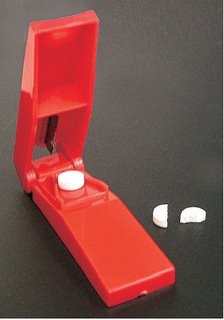
Should physicians encourage pill splitting as a way to help patients save money?
Splitting pills can help patients save money:
The first time that a patient asked me to write a prescription for a higher dosage of a medication was in the late 1990s. Viagra was a highly desired medication for some older male patients, but at $10 a pill, many couldn't afford that much of it. But these motivated patients soon learned that both the 50-mg and 100-mg tablets cost the same amount. Splitting the higher-dose pills effectively gave them a 50% discount.
Many of the world's best-selling drugs, including Lipitor, Zocor, and dozens of others, are priced similarly, with higher doses carrying the same price tag as lower doses. These medications are candidates for cost savings by splitting tablets.
However, pill splitting has its risks:
Splitting pills can be dangerous for certain types of patients and for certain medications. The difficulty is determining what medications can be safely split and for which patients.
Medications that have special enteric coatings, have extended-release formulations, or are capsules containing powder or gel are some examples of those that should never be split.
Another category of medicines that are dangerous for pill-splitting are those that have a narrow therapeutic index, where precise dosing is a critical element of the therapy. Even with pill- splitting devices, splitting the medicine can result in a plus or minus 20% variation in the effective dose.
Similarly, there are certain types of patients who are not good candidates for pill splitting, such as the elderly, patients suffering from dementia, and those with visual impairments or other conditions that would make it difficult for them to split a pill precisely.
So even if you had a medication that might appear to be safe to split, there are always going to be patients for whom the practice is going to be risky.
Another risk of pill splitting is confusion about the dose of medication. For example, a patient may have a bottle full of 40 mg blood pressure pills. If he goes to the ER with his bag of meds, the ER doc may think he is taking 40 mg daily of the medication rather than the 20 mg his primary care doc told him to take. I've seen this happen before in busy ER's and inpatient services.


3 comments:
Nice Post Love Reading Its
generic Viagra
silagra pills
thank you for these great instructions on pills splitting. they will help me save money on some meds that i can buy cheaper in larger dosages kamagra 100 bestellen
It looks like a useful instrument. i usually cut them with a knife and often crush them.
Post a Comment